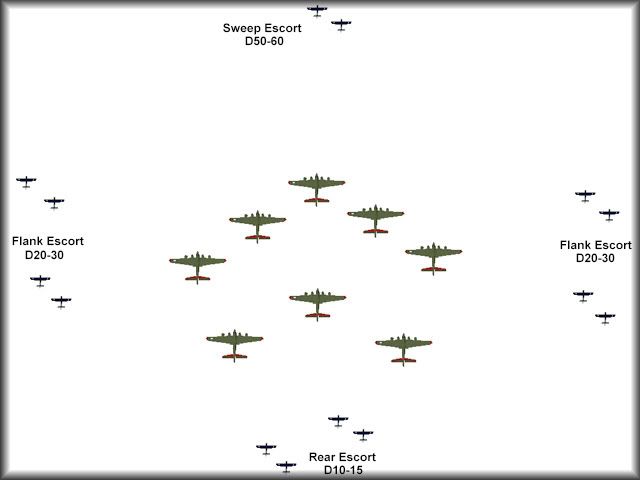Here is some basic information i found on bomber escort formations and the Basic distance and tatic's they imployed:
Bomber Escort[/color]
In real life, bomber escort did not work very well. True, it worked better than sending the bombers in alone, which is how the Americans tried it at first. But even after the Allies started sending fighter escorts with the bombers, it was only marginally successful and bomber losses were still unacceptably high.
The problem was that the escorts were initially deployed in a close escort formation, i.e., in relatively close proximity to the bombers. The bomber crews preferred this, as they could look out their windows and see their "little friends" out there.
But it was not completely effective. Close escort cannot stop a good interceptor group from making a high speed head-on pass. In fact, if the escorts stay in close escort formation, they cannot stop that same interceptor group from making multiple passes.
Bomber escort did not really begin to work well until the 8th Air Force freed their fighters from having to fly close escort. Instead of being tethered to the bombers, escort fighters roamed ahead and to the sides of the bomber streams, often far beyond visual range, in an attempt to intercept the Luftwaffe before it could form up. Setting up a good head-on pass against a bomber formation requires about 10 miles of undisturbed flying as the interceptors make their approach, and that was not possible when that 10 miles was filled with Allied fighters.
In WarBirds as in real life, the most effective escorts are the ones you don't see from the bomber stream - the ones who are engaging the interceptors before they are in visual range of the bombers.
Nonetheless, in real life and in WarBirds, forward sweeps cannot get every interceptor, so close escort is still necessary to prevent interceptors from being able to sadde up on the bombers at their leisure.
Typical Close Escort Formation[/color]

The picture above shows a typical close escort formation, with flank escorts, rear escort, and a forward sweep. The latter is the group furthest away from the bombers, usually out of visual range, and is the group's defense against the head-on pass.
Notes[/color]
You want as much distance between you and the bomber stream as you can get and still be able to see - and get to - the bomber group. The more distance you have, the more time you have to interfere with bandits on their way to the bombers. Escorts shouldn't hesitate to move beyond visual range of the bombers if they spot bandits further out.
The escorts usually stay between 5,000 to 8,000 feet higher than the bombers, so as to have enough energy to turn into attacking fighters.
The conventional wisdom is to stay with the bombers, to break off enemy fighters when they cease to be a threat, and especially not to follow enemy fighters to lower altitudes. This may or may not be the right response, depending upon the circumstances. In an event, where every downed pilot means one less enemy plane, it is often better to release some escorts to follow and kill known bandits, even if they are trying to leave. In an arena, where there are always more enemy planes to come, it is usually best to stay with the bombers rather than chase bandits.
If fuel permits, maintain your position relative to the bombers by keeping your speed high and flying at angles to the bomber stream. You will be faster than the bombers, and the temptation is to throttle back and fly level with them. You can do this if you are sure no bandits are around, but otherwise, you want to keep your speed high so that when they do show up, you have the energy to deal with them. Stay in position by flying at angles to the bombers. For example, if the bombers are holding 90 degrees, fly 120 degrees for a while, then turn to 60 degrees until you're back in position, then repeat.
If you have bandits hitting the bombers in a head-on pass, fire your guns at them, even if there's no hope of hitting them. A head-on pass is a tricky thing. It takes place at closure speeds of 500 mph or faster and aiming is very difficult. If the shooter flinches on the approach, it can mean the difference between a bomber kill and a clean miss. Fill the air with tracers, make him think he has to take evasive action or die.
"COMMENTS?"